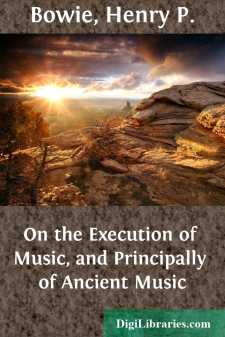Categories
- Antiques & Collectibles 13
- Architecture 36
- Art 48
- Bibles 22
- Biography & Autobiography 813
- Body, Mind & Spirit 142
- Business & Economics 28
- Children's Books 12
- Children's Fiction 9
- Computers 4
- Cooking 94
- Crafts & Hobbies 4
- Drama 346
- Education 46
- Family & Relationships 57
- Fiction 11828
- Games 19
- Gardening 17
- Health & Fitness 34
- History 1377
- House & Home 1
- Humor 147
- Juvenile Fiction 1873
- Juvenile Nonfiction 202
- Language Arts & Disciplines 88
- Law 16
- Literary Collections 686
- Literary Criticism 179
- Mathematics 13
- Medical 41
- Music 40
- Nature 179
- Non-Classifiable 1768
- Performing Arts 7
- Periodicals 1453
- Philosophy 64
- Photography 2
- Poetry 896
- Political Science 203
- Psychology 42
- Reference 154
- Religion 513
- Science 126
- Self-Help 84
- Social Science 81
- Sports & Recreation 34
- Study Aids 3
- Technology & Engineering 59
- Transportation 23
- Travel 463
- True Crime 29
On the Execution of Music, and Principally of Ancient Music
by: Henry P. Bowie
Description:
Excerpt
USIC was written in a scrawl impossible to decipher up to the thirteenth century, when Plain Song (Plain Chant) made its appearance in square and diamond-shaped notes. The graduals and introits had not yet been reduced to bars, but the songs of the troubadours appear to have been in bars of three beats with the accent on the feeble note of each bar. However, the theory that this bar of three beats or triple time was used exclusively is probably erroneous. St. Isidore, in his treatise on music, speaking of how Plain Song should be interpreted, considers in turn all the voices and recommends those which are high, sweet and clear, for the execution of vocal sounds, introits, graduals, offertories, etc. This is exactly contrary to what we now do, since in place of utilizing these light tenor voices for Plain Song, we have recourse to voices both heavy and low.
In the last century when it was desired to restore Plain Song to its primitive purity, one met with insurmountable obstacles due to its prodigious prolixity of long series of notes, repeating indefinitely the same musical forms; but in considering this in the light of explanations given by St. Isidore, and in view of the Oriental origin of the Christian religion, we are led to infer that these long series of notes were chants or vocalizations analogous to the songs of the Muezzins of the Orient. At the beginning of the sixteenth century musical laws began to be elaborated without, however, in this evolution towards modern tonal art, departing entirely from all influence of the antique methods. The school named after Palestrina employed as yet only the triads or perfect chords; this prevented absolutely all expression, although some traces of it appear in the "Stabat Mater" of that composer. This music, ecclesiastical in character, in which it would have been chimerical to try to introduce modern expression, flourished in France, in Flanders, in Spain at the same time as in Italy, and enjoyed the favor of Pope Marcellus, who recognized the merit of Palestrina in breaking loose from the grievous practice of adapting popular songs to church music.
In the middle ages, as in antiquity, the laws of harmony were unknown; when it was desired to sing in two parts, they sang at first in intervals of fifths and fourths, where it would have seemed much more natural to sing in thirds and sixths. Such first attempts at music in several parts were made in the thirteenth, fourteenth and fifteenth centuries, when they were hunting for laws, and such music was discordant. It bore the name of Diaphony. The real Polyphony came in the sixteenth century with the school of Palestrina.
Later on, little by little, laws were established, not arbitrarily, but laws resulting from a long experience, and during all the sixteenth century admirable music was written, though deprived of melody, properly speaking. Melody was reserved for dance music which, in fact, was perfectly written in four and even in five part scores, as I have been able to convince myself in hunting for dance music of the sixteenth century for my opera "Ascanio."
But no indication of movement, nuances or shading, enlightens us as to the manner in which this music should be interpreted. At Paris the first attempts to execute the music of Palestrina were made in the time of Louis Philippe, by the Prince of Moscow. He had founded a choral society of amateurs, all titled, but gifted with good voices and a certain musical talent. This society executed many of the works of Palestrina and particularly the famous "Mass of Pope Marcellus." They adopted at that time the method of singing most of these pieces very softly and with an extreme slowness so that in the long-sustained notes the singers were forced to divide their task by some taking up the sound when the others were out of breath. Consonant chords thus presented evidently produced music which was very agreeable to the ear, but unquestionably the author could not recognize his work in such rendering....


